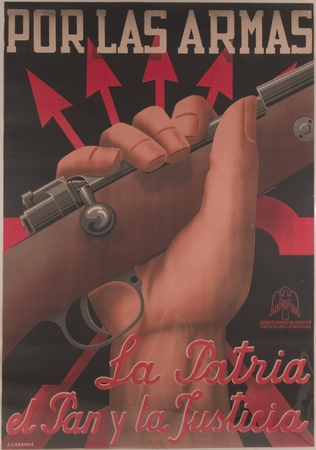Por las armas
la patria, el pan y la justicia, To arms: country, bread and justice
- Collection
- Description
-
Large hand wielding rifle
This poster is one of the few nationalist posters in this exhibit (see also posters 56, 79 and 83). A hand clutching a rifle occupies the center of the poster as the message endorses military action in order to reach the goals of a secure fatherland, food for its citizens, and justice. Behind the hand is the symbol adopted by the Falange and Spanish fascists. The symbol is el yugo y las flechas (the yoke and the arrows) in which four arrows intersect with a yoke. Like the political groups on the revolutionary left, the Falange was fond of the color red and its revolutionary implications. Consequently, the symbol often appears in red and red is a predominant color in the poster.
This particular choice of symbol would have been particular meaningful for members of the Falange and the Nationalists. The images el yugo y las flechas were created for the monarchs Isabel and Ferdinand, who ruled in the late fifteenth and early sixteenth centuries. The first letters of the names of the two parts of the symbol, Y and F, correspond to first names of the two monarchs with Isabel spelled in the older style of Ysabel. In Spanish history, the marriage of Ferdinand and Isabel represented a unification of the two kingdoms of Castile and Aragon in which Spain as a whole was created. Thus, the overtones of monarchism and unity contained in this symbol would have resonated well with the Nationalist goals of repairing a divided Spain and returning to a more traditional form of governance.
The artist of this poster is Juan Cabanas (b. 1907). Cabanas was the son of the impressionist painter Angel Cabanas Oteiza. In 1924, he moved to Madrid and studied at the Escuela de Bellas Artes de San Fernando (San Fernando School of Fine Arts). Two years later, he went to Paris where he discovered surrealism. He dabbled in surrealism both in the form of images and texts. Later in his life, he would destroy all of his surrealist works. During the Civil War, he made many posters for the Falange, which later became the state political party of Nationalist Spain. Eventually, he was named the head of the Sección Plástica de Prensa y Propaganda (Expressive Section of the Press and Propaganda) and the Protocol de Franco (Franco's Protocol). After the Civil War, in 1945, he traveled to Buenos Aires and Santiago, Chile to study mural painting. - Creation Date
- 1938
- Creators
- Physical Description
-
1 print (poster) : lithograph (col.) ; 98 x 68 cm
- Geographics
- Genres
- Topics
Format
View formats within this collection
- Identifier
-
Mms: 991000043419706535
- Related Resource
Online exhibit
- Classification
-
DP269.15.P377 1938
- Publication
-
Madrid?, Departamento de Plastica, Servicio Nacional de Propaganda (sp)
- Copyright
-
Unknown
Use: This work is available from the UC San Diego Library. This digital copy of the work is intended to support research, teaching, and private study.
Constraint(s) on Use: This work may be protected by the U.S. Copyright Law (Title 17, U.S.C.). Use of this work beyond that allowed by "fair use" requires written permission of the copyright holder(s). Responsibility for obtaining permissions and any use and distribution of this work rests exclusively with the user and not the UC San Diego Library. Inquiries can be made to the UC San Diego Library program having custody of the work.
- Digital Object Made Available By
-
Special Collections & Archives, UC San Diego, La Jolla, 92093-0175 (https://lib.ucsd.edu/sca)
- Last Modified
2024-07-20
 Library Digital Collections
Library Digital Collections
